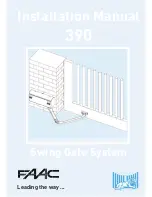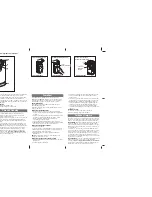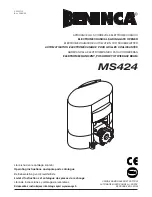
15
EN
Initially, the procedure consists in the installer entering, with
the aid of the programming unit “O-Box”, the required func-
tions and the relative receiver “certificate” in the memory of
the transmitter. The transmitter, ready to use, is then sent to
the client.
Subsequently, when the transmitter is used, it will transmit the
command along with the “certificate” to the receiver (
the first
twenty times only
). The receiver, after recognising the “certifi-
cate” as its own, automatically memorises the identity code of
the transmitter that sent the certificate.
12
–
REMOTE REPLACEMENT OF A
TRANSMITTER USING “PRIORITY”
MODE
[with O-Box]
– The identity code of a transmitter in the
NiceOne series is accompanied by a
number
(from
0
to
3
),
which enables the user to specify the transmitter’s
priority
level
on a receiver with respect to any other transmitters with
the same code.
This “
priority
” serves to replace, and thus disable, use of a
transmitter that has been lost or stolen, without the need to
return to the client’s system.
Use of priority mode requires knowledge of the code of the
lost transmitter and enables maintenance of the same code
and functions of the previous transmitter.
Therefore the lost transmitter can be disabled by simply
updating the priority level
of the new transmitter with the
next highest value.
On first use of the transmitter, the receiver memorises the
new
priority level
received and ignores any command sent by the
lost or stolen transmitter if subsequently used.
This function can be enabled (or disabled) on the receiver
(fac-
tory setting
ON
)
and, when active, the receiver does not
update the priority level sent by the transmitter.
13
–
ENABLING (or disabling)
RECEPTION OF NON-ORIGINAL
“IDENTITY CODES”
[with O-Box / O-View]
– The identity codes of transmitters
with “
FloR
” and “
O-Code
” encoding can be modified as
required, using the “O-Box” or “O-View” programming unit.
The receiver can normally recognise whether a code is original
(factory set) or modified.
When this function is enabled or disabled
(factory setting
ON
)
the receiver has the option to accept (or not) the command of
a transmitter with a modified
identity code
.
14
–
LOCKING (or unlocking)
THE MOBILE SECTION
(Rolling code)
OF THE IDENTITY CODE
[with O-Box / O-View]
– This function enables the user to
lock (or unlock) management on the receiver of the variable
section
(rolling code)
of an identity code sent by a transmitter.
When the lock function is active
(factory setting
OFF
)
, the
receiver treats a “rolling code” as if it were a “fixed” code,
ignoring the variable section.
www.ApolloGateOpeners.com | (800) 878-7829 | [email protected]








































